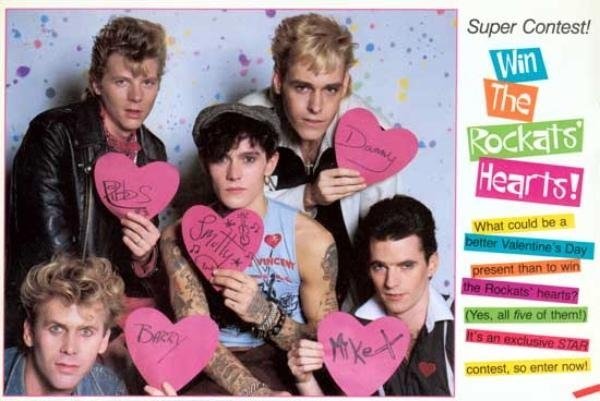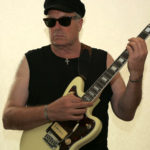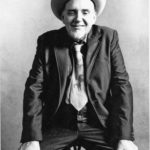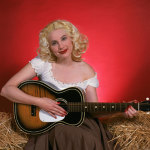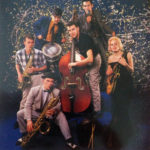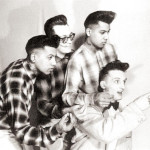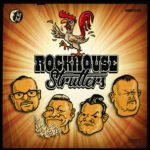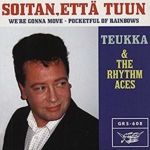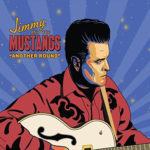The Rockats
My first contact with the Rockats was not musical but visual. I clearly remember seeing the cover of “Live At the Ritz” in a French Rock magazine. I found it terribly cool and for the kid that I was, it looked like the incarnation of cool. The five guys pictured on the cover had it all, the attitude, top haircuts, a double bass, flashy clothes (having a pair of red trousers became my new obsession), bow ties… I was ready to surrender even before the first listen, which, once I finally put my hand on the so coveted album, didn’t disappoint me.
The Rockats created neo-rockabilly – or most probably the term was created for them – and influenced countless bands from New York to Helsinki via Tokyo.
In 2013, they returned with their classic line-up (Dibbs Preston on vocals, Barry Ryan and Danny Harvey on guitar, Smutty Smiff on double bass and both Mike osborne and Lewis King on drums) and an amazing album proving that they could show the young generation how to rock!
by Fred “Virgil” Turgis
Early years
The first half of the 70’s brought a resurgence of interest in Rock and Roll and Rockabilly with bands like Crazy Cavan and the Rhythm Rockers, the Riot Rockers, Flying Saucers etc.
The young Levi Dexter grew up in Chelsea, London then moved to Southend-On-Sea “A big Teddyboy town. It was very strict musically. Nothing after 1959.”¹ At the age of 15 he already ran an Elvis Presley fan club and soon after went to see gigs by all the great Teddy Boys bands. One day at a Crazy Cavan show, he was asked by Cavan to climb on stage to sing a tune or two. After that thrilling experience, Dexter jammed with bands whenever the occasion arose.
In June 1977 following a jam with Shakin Stevens’ band, the Sunsets, Levi got in touch with Leee Black Childers who at the time was the manager of Johnny Thunder and the Heartbreakers and was also famous for his work with Mott the Hopple and David Bowie. Childers gave Levi his card and an appointment for the next day. It was a chance not to be missed for the young aspirant singer.
The next day they talked about setting a band “Leee said it was just as important to have cool, good looking guys in the band regardless of their talents. He already knew Eddie Dibbles (later know as Dibbs Preston) from the nightclubs and said ‘He plays guitar… He looks great… He’s in’!.” Dibbs was a Ted who started to become interested in Rock’n’roll around 1976 “I was about 16 years old when I first wanted to play the guitar. At the time the punk rock movement in the UK was just beginning it was 1976/77 so a lot of my mates were getting into that life but my home town of Harrow in London was always a big ‘Ted’ town and I was mates with Steve Chapman now of Spindrift records and he had all the rare rockin’ stuff on singles from America so both music styles were around for me to get into. I remember the first punk band I saw live was the first performance of Johnny Thunders and the Heartbreakers in London at the Marquee. The next week we went to see Crazy Cavan at the Royalty ballroom!”
This open minded state of mind would later be a trademark of the Rockats.
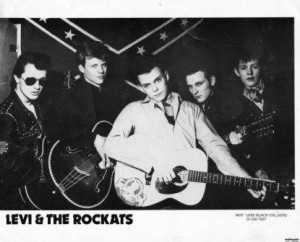
The next one to join the band was “Smutt” Smiff, the tattooed bass player. In an interview with punkglobe.com, Levi remembers how Smutty joined the band “A few days later me and Leee went to the Royalty in Southgate on one of their 50’s rockin’ nights and stood in the balcony looking down at all the people dancing. ‘Who’s THAT’ he said ‘He’s perfect’! I said ‘It’s my good friend Smut. I lived with his family for years’. He approached Smut and said ‘Drums or bass’?? Smut said ‘Drums’ and Leee said ‘Oh no! With all those tattoo’s he’s gotta’ play the upright bass’.” The young Smutty discovered Rock’n’roll at a very early age “The first band I can remember seeing was ‘Crazy Cavan and The Rhythm Rockers’. I lied about my age to get in and was blown away. I knew at that moment that I was hooked on Rock N ‘Roll and nothing else mattered”² He and Levi became friend through their mutual love and music. In term of looking cool, Leee couldn’t find a better man than the tattooed kid “My first tattoo was done on my Mum’s kitchen table when I was fourteen or fifteen by a mate who had made a tattoo machine… I think it was either a small creeper shoe..or the name Gene Vincent…”
The band was soon completed by the addition of Don Devereaux on drums with Mick Barry on second guitar.
The newly formed band played its first show on November 10th 1977. They were pretty rough and to Dexter’s own admission “We weren’t that great but we made it through the set. On the encore Johnny Thunders joined us for a Chuck Berry medley and saved the day. Everyone went crazy.” From that moment the band played regularly on the London scene both for Teds and Punks appearing at the Marquee, the 100 Club and Speakeasy Club. On February 25th, a feature in the Sounds read “Listening to them you are immediately aware that they are infusing Rockabilly with an energy and vitality that has been lacking, simply by adding the magic ingredients, Youth and Energy.”.
USA
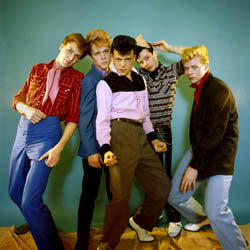
Left to right: Guy Hemmer, Dean Thomas, Levi Dexter, Smut Smith, Eddie Dibbles
In Spring 1978, Levi moved to the USA where he was later joined by Dibbs and Smutty. After spending some time visiting the South, the band reformed with Guy Hemmer (whom Smut had met in Kentucky) on second guitar and Dean Thomas on drums. They relocated to New York and lived for a time in Blondie’s loft.
In November they made their American debut by opening for the Cramps at the legendary Maxs Kansas City “It was awesome. The Cramps became my favourite American band at that point.” recalls Dexter.
Levi and the Rockats soon became a instant sensation on the New York scene with many reviews in magazines and sold out shows.
In December they recorded a demo for RCA who had just signed Robert Gordon. Once the recording session finished the band went back on the road touring from Saint Louis to Los Angeles where they gained new fans and played more sold out shows. They remained in LA for a while and started to really make some noise in the medias. On April 3rd they appeared on the Merv Griffin tv show on which they insisted to play their two songs, “A Note From the South” and “All Through the Night” live (also because they hadn’t released anything yet and thus had no record to mime on).
Their second appearance on national TV, took place on May 18th performing “All Through the Night” and “Rockabilly Idol” on Wolfman Jack’s The Midnight Special.
They then decided it was time to put some music on wax. The demo cut for RCA didn’t lead to a contract, so it was decided to release two 7” on their own Kool Kat label. The first one had “Room to Rock” backed with “All Through the Night” and the second one featured “Rockabilly Idol” on one side and “Note from the South” on the other. Both are first class rockabilly, still anchored in the tradition but played with energy and passion.
In June they flew back to England to headline the Venue in London.
Back in the States, more gigs followed including a performance at the legendary Louisiana Hayride on July 12th. That special show, the first by a Rockabilly band since Elvis played there in 1956, was recorded and later released on album on the Poshboy label in USA and Rockhouse in Europe. For Levi it was “one of the most special events we ever played. We did feel very honored. Backstage we were asked ‘Do you want to use the Elvis microphone or the Hank Williams microphone’? Leee answered ‘He wants to use the Levi Dexter microphone’!”. Rock’n’roll or what?
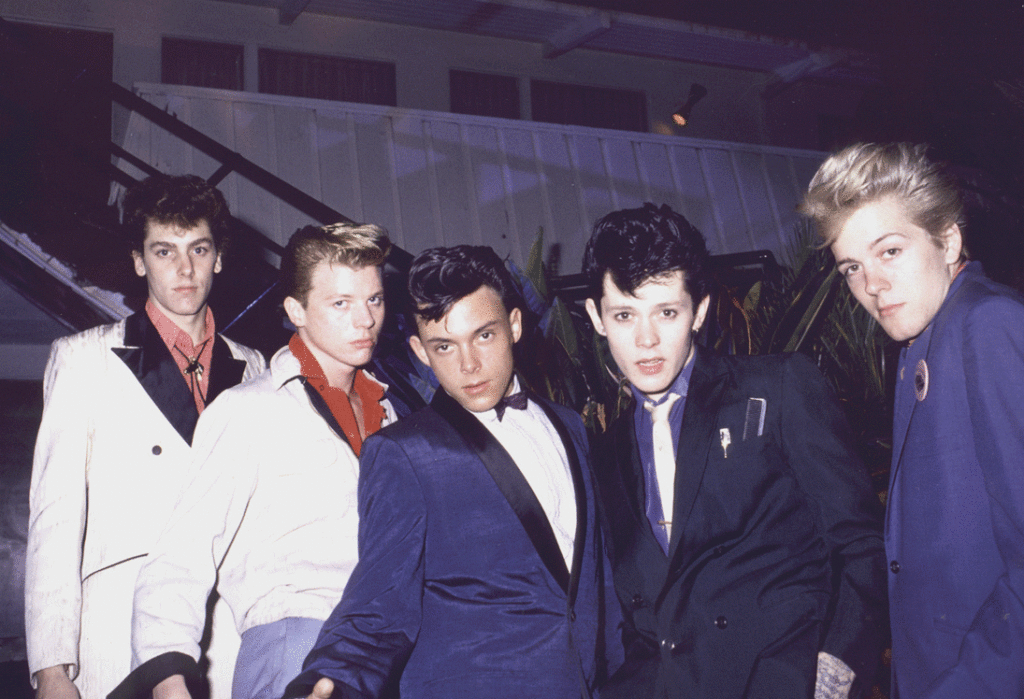 They then went back to New York (“We went to Memphis and all we found was Led Zeppelin and Kiss. Nobody there knew what Rockabilly was. Only a few of the old people knew. And this is where Rockabilly started. So we moved to new York” said Smutt to the Michigan Daily on October 17, 1980) where they kept on gigging and hanging around with the jet set, including Andy Wahrol and the Factory mob. They were featured on one of the Pop art artist’s cable TV show being interviewed by Debbie Harry which resulted in an apparition of the band in Blondie’s video “Dreaming”.
They then went back to New York (“We went to Memphis and all we found was Led Zeppelin and Kiss. Nobody there knew what Rockabilly was. Only a few of the old people knew. And this is where Rockabilly started. So we moved to new York” said Smutt to the Michigan Daily on October 17, 1980) where they kept on gigging and hanging around with the jet set, including Andy Wahrol and the Factory mob. They were featured on one of the Pop art artist’s cable TV show being interviewed by Debbie Harry which resulted in an apparition of the band in Blondie’s video “Dreaming”.
When Dean Thomas left the band to form his own blues combo, the band hired Jerry Nolan of the Heartbreakers to play drums.
With articles in the New York Times saying that “{Levi} has developed his own style and is a convincing urgent performer. The band backs him with a wild and sometimes crazed conviction that’s a lot closer to the rockabilly spirit than the efforts of more archivally minded performers.” the band was on a roll but all was not too well. They were tired of being on the road and there was a bit of frustration from Eddie and Smutty to be associated with the image of a “nostalgia band” and by December the band had split, performing their last show as Levi & the Rockats on December 16th.
The Rockats
The Rockats briefly kept on playing as a trio with Smutty on bass, Eddie Dibbles – now taking the name of Dibbs Preston – on guitar and vocals “I was always very comfortable as a singer more so than a guitar player and I sang a few songs in Levi and the Rockats anyway so when Levi left the band it seemed only natural that I should become lead singer.” and with Jerry Nolan (ex-New York Dolls/Heartbreakers) on drums.
Though his stay with the Rockats was relatively short, the influence of an experienced musician like Nolan was very important in the band’s development on many levels. In a “questions and answers” with the fans on his website, Dibbs evokes the late drummer in those words: “He was a complex character and being the age I was when we played together in Levi and the Rockats and later The Rockats I might not have understood him all that well at the time. Now of course, I do and look back on the time we spent together with great fondness. (…) Being older and more experienced than us at the time he did have quite an influence on us but to his credit he never tried to push any thing on us if you know what I mean. The best thing about Jerry as far as I was concerned was his drumming. He sure made it swing! Such an easy danceable beat yet when needed to could really rock the house with a heavy punk rock style. I’m lucky to have played with and known one of the great rock and roll drummers.” Lewis King who later joined the Rockats in the drummer’s seat adds “While at first I couldn’t take Smutty or Dibbs’ on-stage antics seriously, I was struck by Jerry. He had swing, power and drive… and great hair and clothes. He had real personality behind the kit, which is rare. There are so many faceless drummers out there but he was what first drew me in, and in retrospect, he was what drove them to have confidence in their own abilities and improve.”
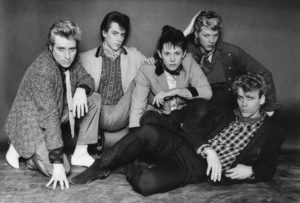
Nolan also played a pivotal role to recruit Barry Ryan one of the two new guitar players. Ryan, a New Yorker, didn’t come from the same background as Dibbs or Smutty. He started to play guitar in the mid 60’s but seriously practised the instrument around 1970. He then formed a band called Tramp. His first influences were English bands like Savoy Brown, Fleetwood Mac and Cream that later turned him to more authentic blues stuff like Elmore James and Otis Rush. This early blues influences will remain an essential part of his style and can be heard in the Rockats whether in an obvious manner in blues influenced songs like Start All Over Again, All My Love, Teenage Letter etc. or in a more underlying way in his solos and textures. His next band was the Victims a punk rock combo formed around 1975 that released two ep’s and one lp’s. Being a part of the New York scene it was inevitable that the Victims crossed path with Levi and the Rockats “I first heard of Levi and the Rockats from Peter Crowley, who was the main person booking bands at Max’s Kansas City. The Victims were frequent headliners at Max’s.This was about 1978. Peter called us to open for Levi &the Rockats at an uptown club and I was impressed by their presentation.I had seen Robert Gordon and Link Wray already and loved them but this had the energy and power that I was always drawn to. I briefly met Dibbs and Smutty backstage but it seems they left for LA shortly after that so we didn’t develope a friendship till later. I remember watching Levi and the Rockats on a TV show in Peter Crowley’s office at Max’s. It looked like the band was going places and we were all happy for them.” When the Victims split, Barry was asked to join The Heros, a new band with Walter Lure and Billy Rath of the Heartbreakers but at the same time Levi and the Rockats parted ways: “Jerry suggested they call me to play guitar and Dibbs would take over the vocals.” pursues the guitar player “Smutty called me and asked if I was interested and of course I said yes. Although I wasn’t a rockabilly guitarist my knowledge of blues made me a quick study. Of course my love of Buddy Holly and Eddie Cochran was a plus. So that’s how it went down.We all got on well with eachother and the dynamics within the group were not overly ridged so I found my place easily.”
Another guitarist, Tim Scott McConnell, was also recruited. McConnell started to play biker bars around Florida at the age of 15, moved to New York when he was 17 and played all the underground clubs such as the legendary CBGB’s, Max’s Kansas City and Mud club.
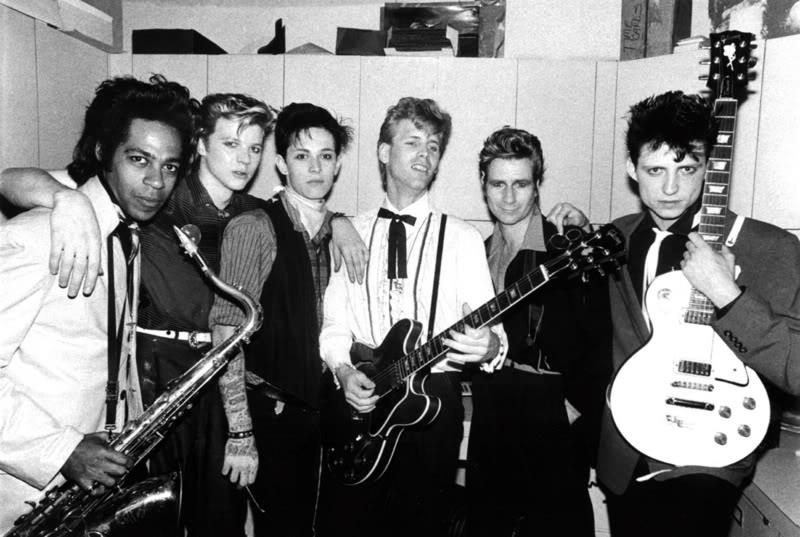
By the end of December the Rockats were ready willing and able.
Their first show was on New Year’s Eve 1979 “Even though we had our self penned original songs in Levi and the Rockats we still had a very purist sound but in the Rockats Smutty and myself seemed to naturally mix it up with a tougher live sound together with a punk edge. I remember our first gig was in San Francisco, New years eve’ 1979 at the Jim Jones temple on the same bill as the Mutants and we had Jerry Nolan playing drums, it was the craziest experience we had up till then! We were Punkabilly!” remembers Dibbs.
For the first half of 1980, the Rockats gigged steadily playing bigger and bigger shows. But soon an old problem began to show his ugly face.
Nolan’s relation with drugs was not a secret but by August his addiction had reached a critical point. Lewis King who knew him well explains “His addiction got in the way of touring, as the band needed to stop at methadone clinics first thing every morning in whatever town they were in. Each clinic has different rules and when they got to Atlanta, they wouldn’t service him and they couldn’t find him any dope. Back to New York he goes and the roadie plays drums for that night’s show (luckily the last of the tour).”
That’s how Nolan’s days with the band ended. Sadly he never recorded with them though a bootleg album recorded in 1980 called “Live at Speak” exists.
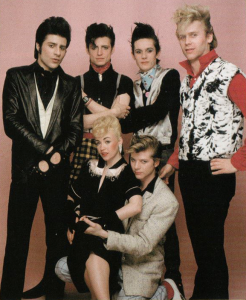
With a dire need of a drummer, the Rockats recruited Tommy Darnell from Staten Island. King who regularly followed the band comments “While being a very animated drummer, {Darnell} was too “Keith Moon” for the band. I could tell he was wrong right out of the gate. Each gig they’d do they’d make him use less and less drums to get him to play less.”
It didn’t stop them and shortly after Nolan’s departure they recorded their first single at the Hit Factory featuring Rockabilly Doll backed with Tanya Jean, two hot boppers and released it on Kat Tales records.
The Rockats had become a rockin’ sensation, especially on the East coast, and soon they started to look for a major label. Looking back, signing with Island was an easy going affair “Our manager booked us to do a showcase for record companies in a club called Hurrahs in New York. For some reason Island was not invited but Chris Blackwell who owned the company was there to meet up with his friend Grace Jones who was a fan of the band.Turns out he was the only one who liked us and came back stage and told us he wanted to sign us. I think we had a meeting the next day at Island and that was it.” remembers Barry. Dibbs concurs “He saw our show on a Saturday night and wanted to sign us up Monday morning! The first thing we did was to buy all new equipment (and) get new apartments in Manhattan”.
It was just one year since Levi & the Rockats broke up, but while one could have feared the worst for the boys, they were ready to embark to London to record their debut album for a major label.
First attempt at recording an album and new drummer
In December the Rockats flew to London (first class of course) to begin the sessions of what would be their debut lp at Basing Street studio off of Portobello Road. “Everything was going good but we didn’t get our sound or feel on tape” remembers Dibbs. “We worked hard for the next couple of weeks but were told the record company wasn’t thrilled with what they were hearing. I was thinking that this was a label who had U2, Steve Winwood and Bob Marley. Maybe they didn’t really get rockabilly (…) Island decided not to go any further with recording and we went back to New York” adds Barry.
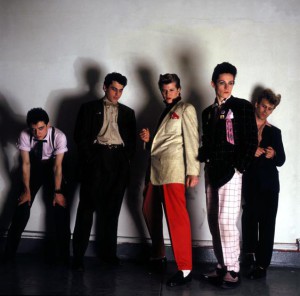
At their return to the States they opened for Tina Turner at the Ritz (January 1st) but quickly realized that Tommy didn’t really fit the band and a change was needed. By that time Curt Weiss aka Lewis King had become familiar with them, having seen them numerous times and met Dibbs through Jerry Nolan: “Living on (Nolan and his girlfriend’s) living room couch was a blond haired Brit who turned out to be Dibbs”. King began to follow the band and “after seeing them a few more times, I realized this was a scene… and the band was very exciting. It was something new while still connecting to the music that the Beatles loved, which is as good a pedigree as there could be as far as I was concerned. I soon got into the clothing and look, and some other bands on the scene like Buzz and the Flyers and soon after Levi and the Ripchords. There were others, but these three lead the way. This was for real. New York had seen nothing like it before. It was a real sea change.”
After an attempt at playing guitar, King started playing drums when he was five years old after seeing Help! Through the Beatles and the covers they played he discovered Chuck Berry, Buddy Holly, Carl Perkins. “Then when punk hit, I could tell that their were elements of it that referred back to that raw, youthful, excitement found in those early rock and roll records. What is early rock and roll but a non-apologetic celebration of youth? Then Robert Gordon and the Cramps started making records and more old collections started popping up. It was all around and I just immersed myself. Plus it was also a lifestyle. I think Lux Interior said the difference between Rock and Rock ‘n’ Roll is that Rock is music but Rock ‘n’ Roll is a lifestyle of which music is only one part. Clothing and attitude are also a part of that lifestyle. That’s what I wanted. Rockabilly and Punk fit the bill.”
And while the Rockats were struggling to record an album, Lewis had morphed into a Rockabilly guy and when they started to look for a drummer a mutual friend recommended him to Smut “He called me up and I went over and met the rest of the band. We rehearsed that night: March 3rd, 1981. The next night, Barry rang my doorbell and asked me if I could rehearse again that evening. The next day (March 5th) we were on the road.”
Live at the Ritz
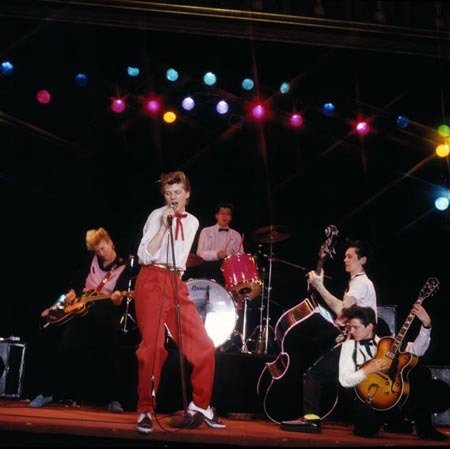
With a new drummer on board and a complete set of songs the Rockats were more than ever ready for their debut album. In order to capture the band’s energy it was quickly decided to record a live album, and from the point of view of the record company it was a way to satisfy the contract without spending too much money considering the fact that thousand dollars had already been spent on the studio sessions of December “(Blackwell) wanted to record us again but thought we would be better captured on a live recording. As no one releases a live album for their debut he also thought it was a good marketing ploy” explains Ryan.
They made some demos prior to the recording for Blackwell to listen. King: “We did do some live demos at RCA studios in mid-town Manhattan just before the live album in the spring of ’81. It was probably a way to see if we could work with Kenny Vance, previously of Jay and the Americans, as producer, and for him to assess our repertoire. Kenny was there as was the engineer Mike Getlin. I thought they were decent and I’d bet there’s something usable on them. I think Dibbs has a copy. They were pretty much all the songs from Live at the Ritz plus whatever was in our set at the time that didn’t make it onto the record: Otis Rush’s “All Your Love”, another song called “You Oughta Be With Me” (it was in 6/8 time.), Tim had a song he sang called “Lonely Game Of Romance”. It had lots of metaphors about playing cards. There might have been a retread from the Levi days too (Note from the South or Other Side of Midnite). We rarely played those though (…) Kenny didn’t change the arrangements much but he kept bringing us songs to try as covers. Our response was always something like, ‘No, Robert Gordon’s done that’ or ‘No, the Stray Cats have done that’. We settled on “At My Front Door (Crazy Little Mama)”, in spite of The Arrows doing it a few years before. It was a bit generic to me and more Doo-Wop than Rockabilly, but that was Kenny’s background. The record company found him and knew he was into Doo-Wop and probably thought ‘It’s all 50’s music. He’ll be perfect.’ Outside of Chris Blackwell, Island never knew what to do with us.”
So in spring 1981, it was decided to book two nights at the Ritz, (“a great place that we had been selling out” comments Barry) to be the venue. And as it had been decided to release the album in stores 48 hours after the shows they had to shoot the cover beforehand and have the sleeves ready. Most of the recordings come from the second night, with very few overdubs except for some bass parts played by Dibbs and the album hit the streets on May 30th. “We mixed it directly after the show in the Rolling Stones mobile studio that was linked to the Ritz hall and I remember early that morning when Tim and me were listening back Ronnie Wood stopped by to check up on the mobile studio. He liked what he heard. I think the recording definitely captured our live energy that night.” comments Dibbs.
After an enthusiastic and drunken introduction by Billy Idol, the gang kicks off with Rockin’ Baby, a boppin’ rockabilly with fine Gallupin’ guitar. By the second song, Rite Time, the doubt is no longer possible: this is 1981 not 1956. The Rockats don’t re-create, they totally make the genre their own by mixing it with Punk energy, as proven by their raw rendition of Cochran’s My Way, covering contemporary bands like Buzz and the Flyers (Go Kat Wild) and writing their own originals (All Thru The Nite; 50 Miles From Nowhere…). Sure, their youthful exuberance sometimes borders to confusion but much to the chagrin of some purists, this attitude is probably closer to what Gene Vincent or Billy Lee Riley sounded on stage and the full platter is a neo-rockabilly rollercoaster. Culminating with the wild Krazy Baby, it also contains a few slower numbers to let you take your breath like the torrid Love this Kat (written by Bobby and Larson Paine who later wrote songs for Brian Setzer and Stray Cats) and the bluesy Start All Over Again, that evokes the early Rolling Stones. Perhaps the production could have benefited of a fuller sound, as King says “I always thought the record sounded too thin and the songs are all too fast, but I was the new guy in the group and only said it to Tim at the time. It sure didn’t sound as good as the Stray Cats or Polecats. Still, it was great to be 21 and see your record in a real record store, but I just wanted to get into the studio and make a “real” record.”
Tim leaves… and Danny Harvey joins in
The line-up (Dibbs, Barry, Tim, Smutty and Lewis) remained steady for a while and they toured to promote the album including an opening slot for the Clash on July 13th. In August they were featured in the Melody Maker. Sadly, around the fall of 1981, Tim announced that he was leaving to form his own band. After looking for a replacement, the remaining members decided to hire Danny Harvey, who played in the Ripchords with… Levi Dexter. Lewis explains this choice “We had seen Danny play with Levi & the Ripchords and heard he had split from them. We liked Michael Gene from Buzz & the Flyers too but didn’t want to poach anyone. Plus we sensed Danny was a more versatile player.” Harvey started to play guitar at age six, and then took lessons with Joe Pass which gave him a solid jazz background. Some times later he got the Rockabilly bug and eventually met Levi Dexter and Brian Setzer. Actually he could have played with the Rockats earlier as he told to Denise Daliege-Pierce in 2008, in issue 84 of Blue Suede News “When Levi and the Rockats split up, Levi asked me if I wanted to start a band with him and, only moments later Dibbs and Smutty asked me if I wanted to join the Rockats as lead guitarist so Dibbs could move over to vocals. I chose to go with Levi (…) A few years later, when I was frustrated with the Ripchords, the Rockats contacted me about joining them again and, this time, I said yes.” Harvey had to move from Los Angeles to New York. In the meantime the band carried on as a quartet with Dibbs back on guitar until the end of the year. Danny officially joined the band on December 14th, and played his first show as a Rockat at the Peppermint Lounge on New Years Eve.
Shortly after, in January 1982, Island dropped the band. As Barry put it, they didn’t really know what to do with a Rockabilly band and the contract allowed them to dump the band in case of a change of members. The replacement of Tim by Danny was the perfect occasion they needed. Without a label, they were also looking for a manager. Jerry Brandt from the Ritz (who had previously managed Carly Simon and Jobriath) was interested but it didn’t materialise. The band also got in touch with John Small, who had managed Billy Joel, but finally Tommy Mottolla’s management company Champion signed the band later that year.
On February 3rd, a benefit was held to support the band since their van and all their equipment (including King’s pink drumkit) had been stolen after a show with Belinda and the Backups in Passaic. Among the bands that played that night were Freddy Froggs, the Drive-Ins, Johnny Thunders and the Kingpins.
In March, before signing to RCA, they went into the studio to record a cover of Marvin Gaye’s One More Heartache and probably their most famous tune Make That Move. Mike Thorne who produced the huge hit Tainted Love for Soft Cell was in charge of the new recordings. It found the band going into more modern territories and adding a good dose of New-wave to their brand of Rock’n’Roll. Initially, Make That Move was first written as a rockabilly tune with a swing beat “Dibbs wrote it in a Runaway Boys sort of vein and that’s how we approached it” explains King “Once we hooked up with Mike Thorne we wanted to pursue something more up to date. We were listening to all the music coming out of the clubs at the time (1981/82). We loved stuff other than Rockabilly: Indie Dance music, Stax/Volt and Reggae in particular. The Rockats were never purists. There were bits of punk, the New York Dolls and the blues in the Rockats sound. Plus at the time the Stray Cats couldn’t get an American deal and their second album, Gonna Ball, had stiffed. We thought that the Rockabilly thing was over. So Thorne came up with “de-swinging” Make that Move and adding the synth bass and piano. It worked.”
During these sessions they also worked on a third song called “I Wonder” that had a U2 kind of riff according to King, but remained unfinished. Also demoed around the same period were “Diamond Ring” and a song called “I’m the Only One“, co-written by Danny, Kathy Valentine from The Go-Go’s and Carlene Carter. The Rockats had even started playing this one live in their set but the song ultimately ended on the Go-Go’s third album “Talk Show”. Listen to the demo here and to the live version here.
One More Heartache and Make That Move (with Smutty on electric bass) were played, lip-synched in fact, on Nickelodeon’s Live Wire and a rough clip was also shot for the later.
In August 1982, ex-Rockat, Tim Scott McConnell called Lewis King to help him record some demos as he wasn’t happy with his band. “It was Tim’s nature: he’d get bored, dissatisfied or second guessed himself easily and wanted to do a wholesale 180.” “They flew me out to Malibu. Just me, Tim, Richard Gottherer, his producer/manager, and the engineer… I think it was Thom Panunzio.” It turned out so well that after the demos, Tim and Richard asked King if he wanted to join him permanently. “It was literally the day before meeting Tommy and the Champion gang.” He continues, “I was 22 at the time so you can imagine how swelled my head was, getting courted by both Gottherer and Mottola. I went with Tim and Richard. I probably was a bit more arrogant than I should have been and in retrospect, regret that.”
Ryan remembers “I was a little surprised that Lewis decided to leave but I sensed something was coming. We all thought he was making a big mistake but no one tried to persuade him to stay. He must have thought our best times were behind us. When in fact he missed out on the really good stuff. Think about it, he leaves to go with Tim (…) then we go on tour with the Go Gos and Flock Of Seagulls playing to 20,000 people a night, do American Bandstand and get a part in a movie“
A new drummer and a new label
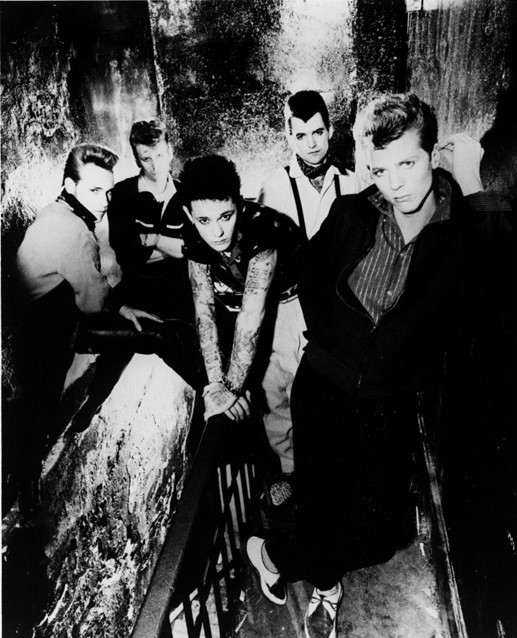
By September 1982 the Rockats had to find a new drummer. Finally Mike Osborn joined in, though the way he came on board remains blurry, at least in Barry’s memories “I don’t recall how we got Mike. Maybe. Lewis told us about him when he left or maybe one of the other guys had seen him play. He was around on the scene and I think he was in a band called Beat Rodeo. He also worked for producer Richard Gotherer tuning drums in the studio.” Actually Beat Rodeo formed after the Rockats (a band in which Lewis King also played) but a Mike Osborn can be found on Marshall Crenshaw’s debut album as well as on Holly & the Italian’s The Right to be Italian. Considering that both albums were produced by Richard Gotherer it could very likely be the same person.
With Tommy Mottola as a manager the guys easily found a new label. In an interview conducted in 2008 by Denise Daliege Pierce for Blue Suede News, Danny Harvey recalled “When we met him he said ‘I’ll get you a major deal in 30 days or you don’t have to pay me to manage you.’ Two weeks later, we were signed to RCA.“³
For a band used to the emergency of Rockabilly, the studio work could sometimes be fastidious “It was fun working in the studio and learning how things got done but there is always lots of downtime when not everyone is needed. ” explains Ryan.
Since the previous session the band departed more and more from the traditionnal Rockabilly sound to explore new territories. The ep was a mix of many influences with straight rockin’ songs (Never So Clever, Go Cat Wild !), more new wave oriented stuff (That’s the Way, One More Heartache) and tunes that were right in the middle of both styles (Make that Move and the excellent Burning, the later always reminded me of Billy Idol’s best tracks like Rebel Yell).
To promote the new album they embarked on a huge tour that saw them opening in stadiums for the likes of Hall & Oates, Flock of Seagulls and so on “We must have toured and played with every major act of the early/mid eighties like Kiss,Bowie,Pretenders,Tina Turner!” comments Dibbs.
In January 1983 they stopped by the label studio to shoot a video-clip for Make That Move under the direction of Steve Kahn, then they hit the road again.
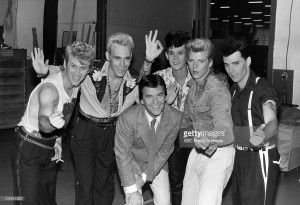
The heavy promotion continued all through the year with highlights like a performance at Dick Clark’s American Bandstand on which they perform Burnin’ and Make That Move. Dibbs recalls “Dick was sitting there with a crowd of kids around him holding up our L.P., “Make That Move” telling a brief history of rockabilly .He then says ”And boy is rockabilly back, its The Rockats!” Dick was real nice to us and gave us each a much coveted AB keyring. After the show he let us sign the wall of fame and told us stories about the famous acts that had appeared there over the years. Doing something like American Bandstand was hard to take in at the time. The only time we would ever see it in England was when early black and white footage of the late 50’s and early 60’s was shown so to actually be on it was such a thrill for Smutty and me. I’ve still got my keyring!”
The Last Bop
By 1984, all this promotion had paid. Make that Move had sold well and topped the MTV charts, but the Rockabilly tag seemed more like a problem for the band than a plus. Stray Cats’ Rant and Rave had ‘only’ gone gold (and they would eventually split in September) and record labels had exploited the scene as much as they could.
Mottola thought that a change of name would allow them to reach a bigger success. Barry didn’t think it was a very good decision “I had this discussion with the other guys that I thought we should stick to Rockabilly, and that this was not going to be good.”5
But, in spite of Barry, they decided to follow Mottola’s advice. A couple of farewell show were scheduled including one last gig at the Ritz, an obvious choice after all, and by June that was it for the Rockats.
They changed their name to Secret Hearts (their initial choice was the Strand but it was copyrighted) and moved to MCA. Still in Blue Suede News, Danny comments: “(Mottola) proposed we change our name and start all over with a new label and his guidance. I’m not sure if it was a good idea, but he said ‘if you’re next LP doesn’t go into the Top Ten we should all quit the business. He got us off RCA and we signed a gigantic deal with MCA as the Secret Hearts.” Under this name they recorded and released a new album. Although the cover sports a picture of Dibbs, Barry, Smutty, Danny and Mike, neither Barry (he’d already left to form Lucky 7 with Kenny Margolis of Mink DeVille) nor Smutt played on it. Instead they had John Sieger from Hall & Oates and Utopia on bass and although Allan Holdsworth was supposed to play guitar the tight schedule didn’t allow that to happen and Danny played all the guitar parts. The guitar player keeps a bitter memorie of the experience (“By far my worst recording experience ever. .“) mainly due to the producer.
Though Secret Hearts, the album, contains some good songwriting, like the excellent Living In the Shadow as well as new recordings of Make That Move and One more Heartache, they definitely miss their rockin’ edge. The album flopped, but signed as Secret Hearts they couldn’t go back to their initial name. Soon after MCA dropped them and they decided to disband.
In Between
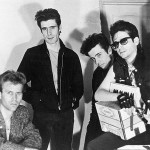
As professional musicians, none of them remained inactive and what they did after the split could make an article of its own. As we saw, Barry was the first to start a new project with Lucky 7. Actually Lucky 7 started around the end of 1983 as a side project of the Rockats with Mike Osborn on drums. The band went through different line-ups and enjoy some success with its mix of rock’n’roll and zydeco.
After a while Smutty moved to Los Angeles and formed the Havalinas with Tim Scott Mc Donnel and they signed to Electra records.
Dibbs played with a band called “Wild Frontiers” that had a single out on Virgin (Ball and Chain). Danny moved back to London in 1986 to join the Twenty Flight Records and collaborated to numerous projects (more at Dannyharvey.com), including stuff with the Fleshtones. Mike Osborn joined Beat Rodeo and played on their first album followed by Lewis King on the band’s second output.
Back on track
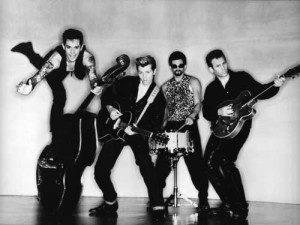
Around 1992, things started to seriously fall apart for Lucky 7, “Kenny (Margolis) and I tried to keep the group going for a little while longer but the fire was gone. So when Dibbs called me up and said he was coming to visit for a while, we talked about doing something together.”5 The newly reformed team gave birth to the Blue Diamonds with Ira Kaye from the Razorbacks on drums and various bass players (Joe D’Astolfo from Lucky 7, Dave Post or Brad Finckle). But before the Blue Diamonds really took off, offers came from Japanese promoters to come and play and soon the Rockats were back on track with Smutty on bass!
After a few rehearsals and some gigs in Los Angeles the quartet flew to Japan for a tour that lasted four weeks. Much to their surprise the response was really wild and most of the venues were sold out. “We had fans there that had never seen us before so we had a good attendance at the gigs” comments Dibbs. “It was nice to see that the Rockats had been taken seriously” adds Barry. A live album, the excellent and aptly titled “Raw in Japan”, was recorded during that tour. It’s a good mix of well chosen covers (My Way, Five Days, Five Days, Lonesome Train, You’re Undecided, Be Bop A Lula) and classics from the band (Make That Move, Burnin’, Start Over Again…).
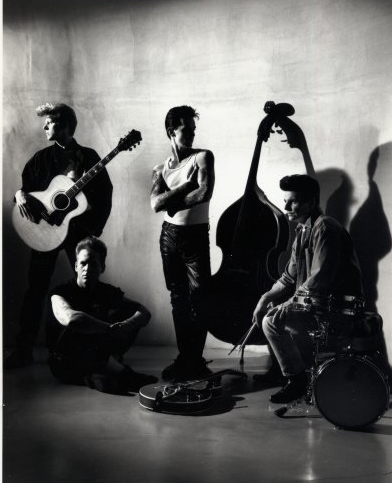
This warm welcome brought a new peak of creativity to the band. In 1994, with Steve Clark on drums, they returned to the studio, the first time since Make That Move and recorded “Downtown Saturday Night”. It’s a mighty fine album made of 10 originals featuring rockin’ songs, ballads, country flavoured tunes with some sax and piano. It proved, if needed, that the Rockats were still at the top of their game, playing classic Rockabilly with a modern approach. It was released in Japan with a four-song mini cd titled the Rockats play Elvis with Heartbreak Hotel, Blue Moon, Good Rockin’ Tonight and Baby Let’s Play House.
They returned to the studio the following year with a new drummer, no one else than Dean Thomas, formerly of Levi and the Rockats, it’s a small rockin’ world after all. The new album called The Good the Bad the Rockin’ proved to be another classic with songs like Pink and Black Cadillac, Off Your Rocker and Barry’s Love You Anyway previously played with Lucky Seven. This song and Say You’re Mine from the same album were later included in the General’s Daughter soundtrack,a movie starring Madeleine Stowe and John Travolta.
In February 1996 the band toured Japan again with the Polecats. Later that year, Smutty left to fully concentrate on 13 Cats an all star band with Tim Polecat on vocals, Danny Harvey on guitar and Slim Jim Phantom (Stray Cats) on drums. His replacement was found in John Willoughby, formerly of the Poorboys. He previously moved to the USA to form Jet Black Machine and later the Spinouts. He also played with British neo-rockabilly legends the Polecats. “Barry and I have known John since 1982 or 1983 when he was a member of the Poorboys. And later when he was in the Polecats.”6 says Preston.
With Willoughby and board and new drummer Jeff Dilena (formerly of Rhythm Bound an excellent Rockabilly band from New York) the Rockats sound changed: a little less neo, a little more traditionnal. One can find on the True Hearted Woman ep released in 2000 an amazing live cut of Downtown Saturday Night recorded live on Radio in London that equals anything done by the Johnny Burnette Trio. “Rollin Thunder” an album containing studio material and live stuff was released in 2001. It’s a good mix of classic covers (Johnny Burnette, Gene Vincent, Carl Perkins) and originals penned either by Ryan or the new team of Preston and Willoughby (“John is also a good songwriter”).
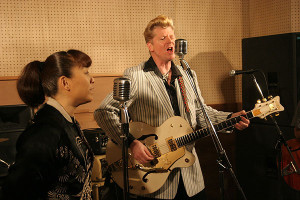
Still in 2001 they collaborated with Conny, a Japanese singer, on her album “Whiskey Boy Trouble Maker”. Not only they backed the singer but also penned seven of the nine songs of the albums, the remaining two being covers of Johnny Burnette’s Rockbilly Boogie and Gene Vincent’s Be Bop-A-Lula. The recordings took place at Prescription Studio in New Jersey with Mike Somocki and Conny later put her voice on it. A mini-tour of Japan with Conny followed in October.
In 2002, the Rockats play Greenbay (during which they also backed Conny) and the L.A Festival (still with Conny).
2003 was another rockin’ year. “Wild Love” was released on Blue Leaf records, featuring the songs recorded for the Conny’s album but this time with Dibbs on vocals, completed by five songs recorded in London with Boz Boorer. In September they returned to Japan for ‘the rockin’ bop” tour which was set up to coincide with the release of “the Last Bop”, a live recording of one of the farewell shows in May 25th 1984 put together by Danny Harvey and Smutty.
“The record company brought us over to promote it, but they insisted on the “84 line-up”. We hadn’t seen or talked to the drummer (Mike Osborne) in 18 years. But we all listened to the cd and met in Tokyo for one rehearsal. It was fun and we always love going to Japan”6.
The year ended with the release of Conny’s X’Mas Rockin’ Party on Conny Records, featuring Dibbs along with Boz Boorer. A mini tour Japan tour (eight shows) with the Japanese singer followed.
Solo releases
Though they never really disbanded, the Rockats seldom played during the following years. Some had the chance to see them play in May 2005 with Brian Setzer at the Blue Comet in Glenside, PA. Setzer played guitar on 20 Flight Rock, Be Bob A Lula, One Night, Tore Up and Rockbilly Boogie and sung Rock Therapy, Something Else and C’mon Everybody with the band. What a show it must have been! They met again for a duet on Unchained Melody in August when they played at Tommy Maguire’s wedding (who used to run Setzer’s website.) But if the Rockats activities slowed down, that doesn’t mean they remained inactive, far from that. Barry played with his own combo and guest with Robert Gordon. In 2008 he released on Blue Leaf his first album under his own name “And God Said Let There Be Rockabilly”. “I had some old songs that I wanted to update along with some new ideas that I’d been working on. I’d been performing with my own band for years, but had never recorded anything. People kept asking me if I had something so I thought I’d better get something out there.”7 says Ryan. On this platter he handles all the lead vocals and performs 10 songs (all originals except for the Beatles “Cant Buy Me Love), some are new others penned for the Rockats or Lucky 7. He later formed Rockabilly Express with Gary Setzer (brian’s brother who played in the Bloodless Pharaohs and in the early incarnation of the Tomcats) on drums and released two albums with that combo.
It was solo times too for Dibbs who launched a new band called “Dibbs Preston and the Detonators”, that leaned more on his Honky Tonk /Bakersfield side that was already evident in some of his previous songs. The album that resulted sounds like a cross between the Rockats, Chis Isaak and Buck Owens and is warmly recommended to any Rockats fans. Preston explains “I always wanted to play in a band with a pedal steel player and get to that kind of roots rockin’ country sound stuff like Wynn Stewart or Buck Owens with that Bakersfield honky tonk feel. The Detonators and myself come pretty close on some songs and we still play when we can locally in Pennsylvania. Now we have added a piano player so we get the boogie woogie happening with the steel on top,it’s Rockin’ man!” The Detonators also allowed Dibbs to play with an old friend: Brian Setzer “When Brian and the Stray cats moved to London we all lost contact for a while and would only say hello now and again.He asked me and my band the Detonators to open for his Christmas tour in 2007 went all over the U.S. We’d finish our set and run straight out to the lobby and sign cd’s and T-shirts we had a lot of fun on that tour. We did it again a couple years later I asked him to write the liner notes to the Rockats last cd,Rockin’ together and he did such a great job on it.He said some really good stuff.Whenever he plays in our area we go and see him and hang out .” Another solo album followed for Dibbs, this time under his sole name in 2010.
Rockin’ Together (again)
In 2008 the classic line-up that recorded Make That Move (Dibbs, Barry, Danny, Smutty and Lewis) got together again for the Texas Rockabilly Revival show. The show was set by Orlando Rios from Rockabilly magazine and Gretsch. This line-up had not played together since Lewis left in 1982. The drummer remembers: “It was (an incredibly fun show). We traded ideas via e-mail, had a rehearsal in a hotel room, a long sound check and did the show. Quick and dirty, but great to play with everyone again. Everyone’s just the same: Dibbs’ is the clown with a card up his sleeve; Smutty’s impulsive; Danny’s the moody pot stirrer; Barry’s dependable; I’m the analyst. Nothing’s changed in over 30 years. We all drive each other nuts but we do love each other. We’ve been through the wars together after all.”
In 2012 after storming shows at places like Green Bay, Quentin Jones of Lanark Records signed the band. King explains “Dibbs knew Quentin Jones from Lanark as they’re close to one another geographically (Dibbs: Philly, Quentin: Lancaster, PA). Lanark is into roots music, so they thought the Rockats would be a sensible add to their roster” An album was scheduled and soon the Make That Move line-up (with both drummers, King and Osborn) was back in studio to record “Rockin’ Together”. Sonically, they never sounded so good, Jones doing a perfect job and the musicians being on top form with great songs. The album kicks off with “The Doubt” a superb modern rockabilly that sets the pace: Dibbs’ vocal on top, solid guitars and rhythm section and top notch production. The title tracks lives to its name. “Why Do You Love Me (If I Don’t Treat You Right)” is a superb modern number that a strong commercial appeal without selling itself. Next is “The Road to Hell” a pure Rockabilly with an Elvis feel and featuring what Brian Setzer calls in his liner notes “the twin rockabilly guitar attack” of Barry Ryan and Danny Harvey. Another highlight for the guitars is the surf tinged instrumental “Kitten with a Whip” penned by drummer Mike Osborn. They prove to be more than able on the honky tonk side with “ Olde Hickory Road ” featuring harmony vocal, piano and pedal steel effect on the guitar. By comparison, Red Headed Rockin’ Gal is more on the blues side, completed by finger snaps for that late 50’s rock’n’roll feel. Another highlight is Sweet Sweet Charlotte a rockaballad in the style of Gene Vincent. Then the album ends with a string of three rockers, starting with Tear the Roof Off (very appropriate name), going harder with “Bad Love” (the kind of thing that could be played by Morrissey when he’s on top rockin’ form) and climaxing with the hot rocker ‘Reckless Rebel” again featuring strong guitar parts.
About the album Smutty comments “My favorite thing about playing again and recording with The Rockats is that after playing with the same guys for so long, we really don´t need to discuss anything in detail. We just know each other so well. When you have been in or around the same band for over thirty years, you know each other pretty well.” Though King expresses some slight reservations “As good as some of the record is, it was a little too slap dash for me. It was somewhat the result of us all being so far apart (Me in Seattle, Danny in Austin, Smut in Iceland) so it needed to be done piece meal. Many great Rockabilly records sound like the band just learned it a few minutes before recording it. That may have been what Quentin was hoping for. In spite of that, I’m more the opposite. I like to woodshed the songs more. But we did start a few fires now and then. My favorites are actually the ones I didn’t play on: the title track and Sweet, Sweet Charlotte. But I also like Bad Love a lot. There were a few that were left off that I hope see the light of day sometime in the future. One thing to note: I can’t look at Dibbs’ when I’m tracking ‘cause he make me laugh too much. He’s like a cartoon character.”
Preston is very happy with it. “It definitely showed us and the fans that we can still deliver on record and we still got it live! Quentin Jones produced the recording and we liked him so much that now he has become a new member of the Rockats playing guitar!” The band played Viva Las Vegas two time in a row (once with Danny in 2013 and the second time with Quentin Jones on second guitar) and still perform sporadically. Though Lanark announced in 2013 that the band cut four songs for a possible ep nothing materialized until now and the Rockats seem to be once again on hold. Let’s hope these rockin’ cats haven’t said their last word and we’ll soon hear more modern Rockabilly from these guys. As Dibbs said to me when I started that article “I know that the Rockats style or sound is not every rockin’ fan’s favourite but at least we always kept the energy and spirit of rockin’ music alive with us”. I guess everyone will agree with that!
This concludes our story of the Rockats. It started with just an interview with Dibbs and finally ended in a 9500 plus words article. And I still have to add a discography to complete it. I sincerely hope I did justice to the band and that you learned a thing or two.
¹ Levi’s quotes come from punkglobe.com ‘Interview with Levi Dexter by Ginger Coyotte” (http://www.punkglobe.com/levidexterinterview0610.html)
² Smutty’s quotes come from http://patternsandtones.blogspot.fr “Smutty Smith: One kool Kat by Julie Pavlowski Green” (http://patternsandtones.blogspot.fr/2013/04/smutty-smith-one-kool-kat.html)
3 Danny Harvey Guitar Hero by Denise Daliege Pierce in Blue Suede News #84 (2008)
4 www.dibbspreston.com
5 Barry Ryan interviewed by Ken Abruzzi in Southern & Rocking #17 and #18 (1997) 6 Kings Amongst Cats – Barry Ryan and Dibbs Preston interviewed by DC Larson in Rockabilly Monthly (March 2004) 7 Barry Ryan to Really Rockabilly
